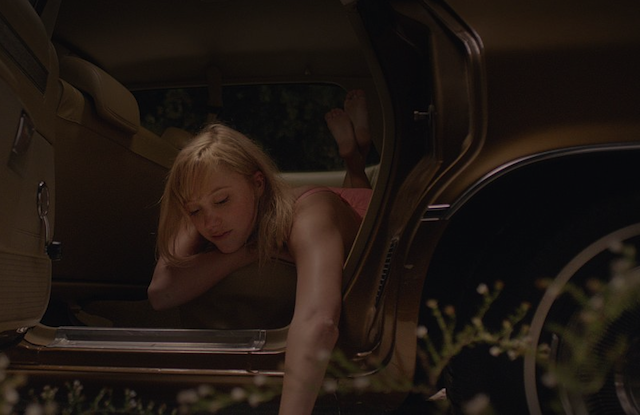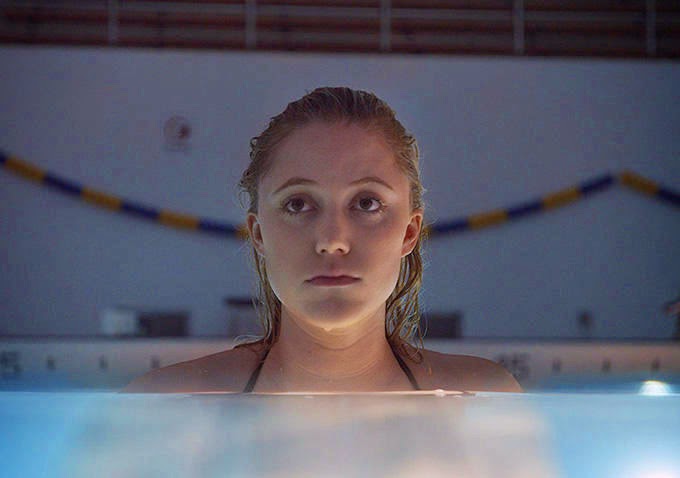It is so easy to make a bad horror movie, and so hard to make a good one. Any filmmaker can momentarily shock audiences with a monster bursting from the closet or a killer slashing from the shadows. But It Follows, David Robert Mitchell’s tense, terrifying second feature, is a master class in horror precisely because of what it doesn’t do. It doesn’t simply rely on a familiar pattern of “Boo!” moments, punctuating moments of dark silence with sudden screams. Instead, it develops a sustained, unrelenting sense of dread, building on its clever premise in smart and tantalizing ways. It chokes you with fear, but it never cheats.
It also serves as a showcase for Mitchell’s undeniable craft. His formal command is evident right from the film’s killer opening sequence, in which a teenage girl, Annie (Bailey Spry), bursts from her house in the twilight hours, wearing heels and looking panicked. She stumbles along the street as her neighbors inquire concernedly, and Mitchell’s camera begins a slow 360-degree turn, eventually relocating Annie as she hightails it in her car, with the soundtrack (by electronica outfit Disasterpeace, aka Rich Vreeland) blaring synths ominously. The following morning, Annie is lying dead on the beach, her bloodied body mangled at an awkward angle, and it’s clear that death is stalking this nondescript Detroit suburb.
It’s an exhilarating rush of an open, and its edgy energy allows It Follows to downshift and establish its characters without stalling out. And so, we meet Jay (Maika Monroe, recently seen running like hell from Dan Stevens in The Guest), whom we first see lounging comfortably in her aboveground pool, casually swatting away the attentions of a pair of Peeping Toms. They aren’t the only ones ogling Jay, as her childhood friend, Paul (Keir Gilchrist), shoots furtive glances at her while his sister, Yara (Olivia Luccardi), quotes Dostoevsky from her seashell-shaped e-reader. But Jay has started dating Hugh (Jake Weary, channeling a young Joshua Jackson), a casually handsome stranger, and after a night cavorting on the beach, they have sex in the backseat of his car. It’s a dreamy sequence, bathed in starlight and suffused with teenage pheromones, at least until Hugh suddenly smothers Jay with chloroform.
Is Hugh a rapist? No, just a plot device. When Jay wakes up, she’s bound to a chair, but Hugh doesn’t want to hurt her; he just needs her to listen while he briskly delivers some critical information. That’s a drag, but every horror movie has to outline its supernatural rules, and It Follows is blessedly brief in its exposition. (It’s also more arresting than most info-dumps, given that Jay receives the distressing news while tied up, with Monroe’s frenzied eyes communicating her utter terror.) Apparently, Jay is now being followed by an indescribable thing—the titular “It”—a demonic force that can take the form of any person and that moseys toward its quarry at an implacable walk, visible only to those it’s hunting. The kicker: The only way for Jay to rid herself of It is to—and the Catholics are going to love this one—have sex, thereby temporarily passing the curse on to the carnal recipient. (Emphasis on “temporarily”: If the creature kills Jay’s new lover, it will again set its sights on her.)
It Follows is hardly the first movie to intertwine sex and death, but it’s downright audacious in its decision to make the link so apparent, and to place the power squarely in Jay’s hands. As a result, the movie doubles as a sort of sexual Rorschach test, producing a subtext that reads differently depending on your point of view. Social conservatives might view Jay’s predicament as a metaphorical indictment of her promiscuity, while feminists could argue that her ability to use sex to cast off the hex is a message of empowerment. For my part, as a narrow-minded critic who perceives everything in relation to other movies, I view the film’s de-facto weaponization of sex as a sly subversion of standard horror tropes. The convention of the genre, born in classics such as Halloween and A Nightmare on Elm Street, is that the lustful are slaughtered and the virginal are spared. But It Follows allows Jay to wield her sexuality as the instrument of her salvation. True, sex got Jay into this mess, but it could also be her saving grace. The choice is hers, yet it’s a choice fraught with complications both moral and practical: Is it fair to ask the smitten Paul to carry her supernatural baggage and thereby grant her a brief reprieve? What about Greg (Daniel Zovatto), the hunky boy who lives across the street? Or should she just seduce a stranger, as Hugh did to her?
Of course, Jay isn’t initially inclined to sleep with anybody; she’s too busy questioning her sanity and trying to suppress her mounting paranoia to contemplate offloading her curse onto an unsuspecting suitor. But once she starts seeing It—always masquerading as a different person, but always lumbering toward her with that inexorable walk—she begins to think twice. That’s why, in order for It Follows to work, it needs to credibly terrorize its heroine, pushing her to a believable breaking point.
And in this, it succeeds spectacularly. It Follows is not an especially complicated movie, but it unsettles both its characters and its audience with extraordinary technique and commendable patience. Combining crisply controlled camerawork with that chilling Disasterpeace score (which owes an obvious debt to John Carpenter’s legendary music for Halloween), Mitchell generates remarkable mileage from his simple premise. The notion that anybody in the room might be a remorseless killer is frightening on its own, but what makes it brilliant is that it lets Mitchell toy with visual perspective. The key is that, regardless of the form that It takes, only Jay can see It—none of her friends can. As a result, any time Jay spots someone walking toward her, she’s immediately paralyzed with fear and uncertainty, wondering if it’s a harmless person or the phantom intent on consuming her.
That’s scary enough for Jay, but Mitchell—who also wrote the screenplay, and whose first feature, The Myth of the American Sleepover, was a scattered but similarly piercing look at teenage sexuality—has more in store for the rest of us. Unlike the typical horror movie—which relies on tightly framed close-ups to create anxiety, bracketing you into close corners with the protagonist—It Follows routinely employs widescreen, Hitchcockian compositions. In so doing, Mitchell often places Jay in the foreground, then holds the shot while someone emerges behind her; because Jay can’t see the approaching figure, we’re poisoned with her own paranoia, unsure ourselves whether we’re witnessing a friendly face or a malevolent force of evil.
It’s a bold, distinctive approach, but it results in a tradeoff: Mitchell is so rigidly disciplined that he rarely petrifies viewers with sudden jolt-scares (though he does indulge in a shocking moment or two). In a sense, It Follows adopts a quality-not-quantity approach to horror. It does not regularly catapult you out of your seat as did James Wan’s The Conjuring, and it may not quite have you constantly shutting your eyes as did Jennifer Kent’s The Babadook. But I’m more than comfortable with that sacrifice, because the looming threat of It’s arrival is pervasive, spawning an atmosphere of unspeakable tension. And when that tension periodically erupts, the results are gripping and electric. Stunningly enough, the movie’s most harrowing scene takes place in broad daylight on a sun-dappled beach, where a languid, idyllic afternoon suddenly turns deadly. The film’s climax, meanwhile, is a bravura episode of terror set at an indoor pool, where Mitchell combines expert framing with low-key special effects to create a singularly horrifying encounter with an invisible foe. (As an added bonus, the characters here actually behave intelligently, unlike your typical horror-movie buffoons.)
Crucially, none of this would work—and indeed, Mitchell’s ruthless craft would perhaps feel a bit sadistic—if it weren’t for Maika Monroe’s enormously sympathetic lead performance. Powered by such a delicious premise, It Follows runs the risk of losing sight of its characters, and apart from Paul, the supporting players here are blurry and vague. But this is Jay’s story, and Monroe brings her to frantic, ferocious life. Jay is by turns tremulous and defiant, helpless and calculating, and Monroe’s tender, persuasive portrayal makes us care about her fate.
At the moment, however, I’m more worried about my own fate. I fear that this movie will lurk in my subconscious for some time, and that when I stand on a darkened street corner or amid a thronging crowd, I will be forcefully reminded of its sinister genius. To remedy this, I’m adopting the pass-it-on logic of It Follows, and I’m urging you to go see it. Maybe, once you do, it will finally stop following me.
Jeremy Beck is the editor-in-chief of MovieManifesto. He watches more movies and television than he probably should.



